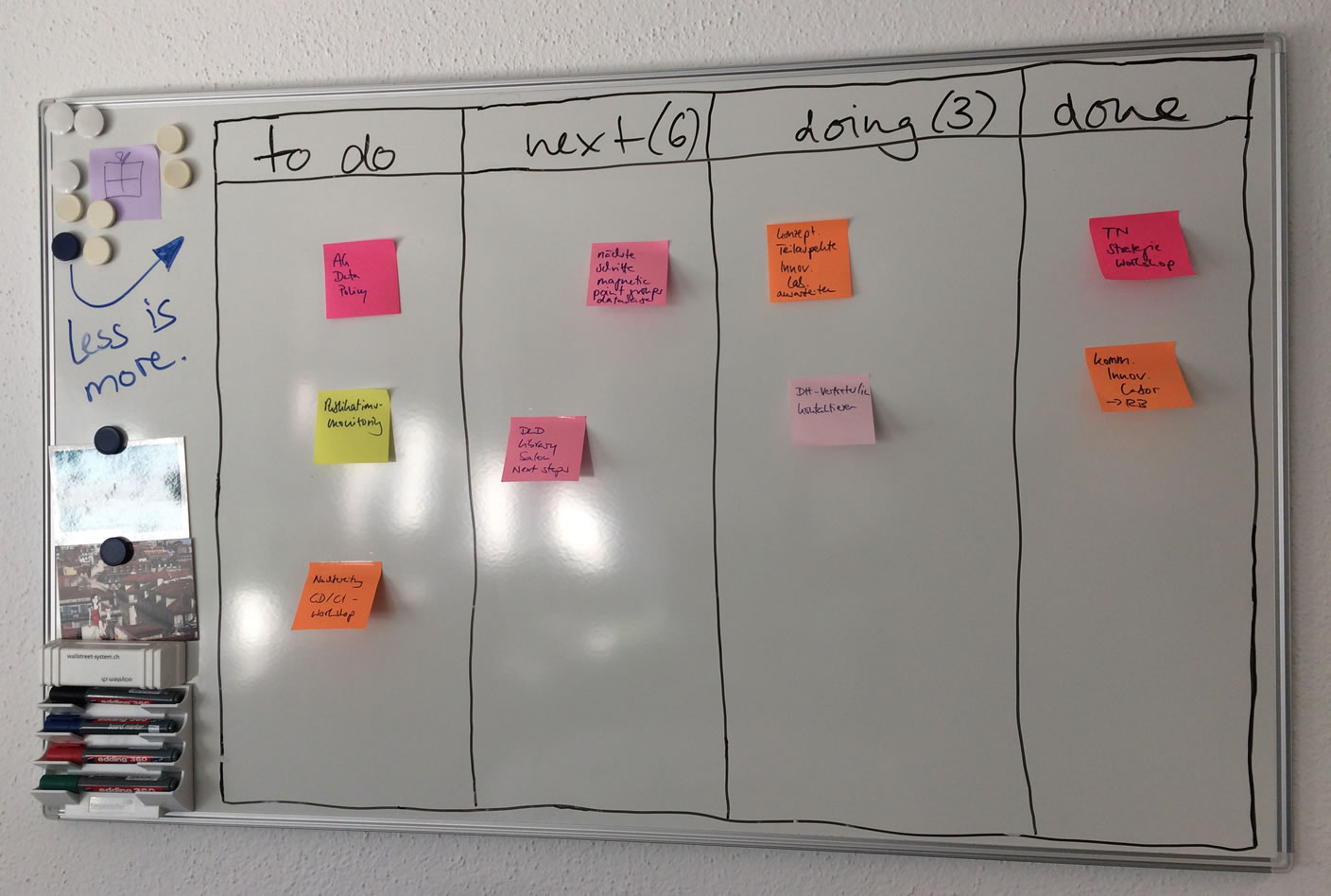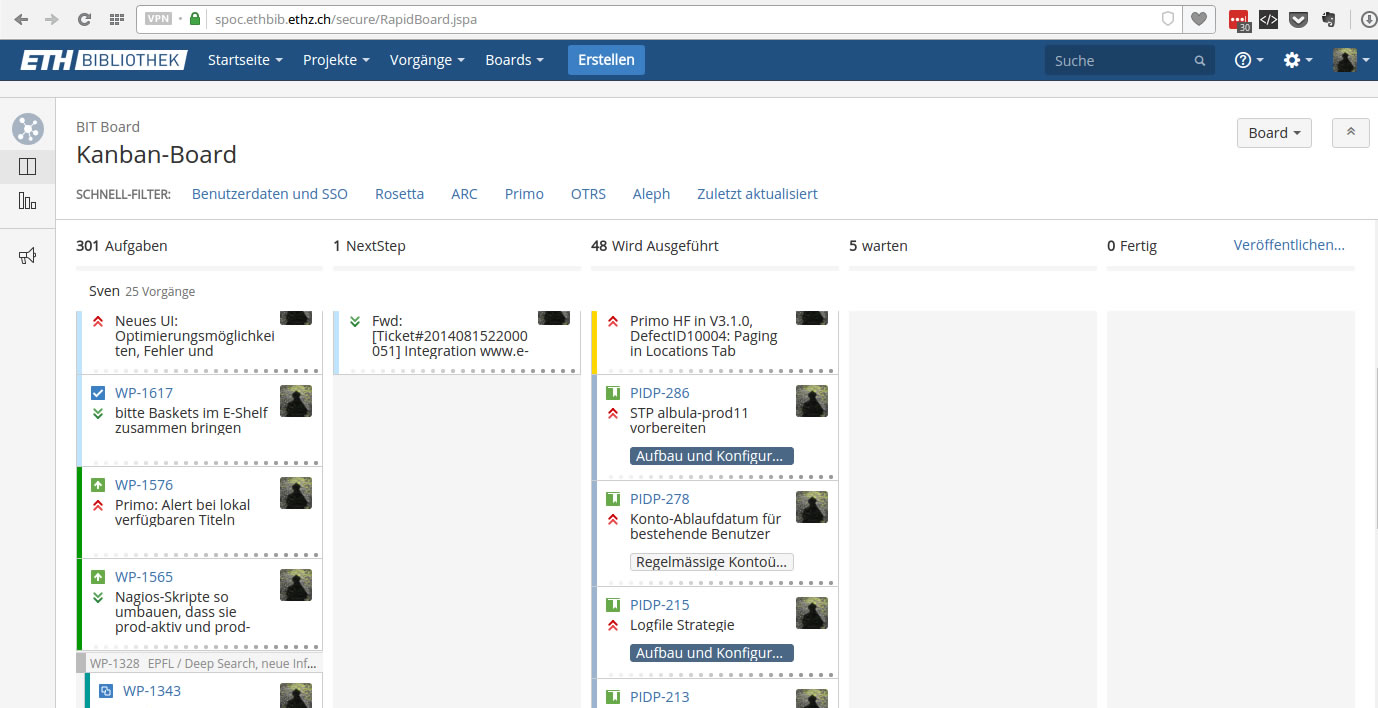[:de]Kanban: Die Kunst, eigene Arbeit in den Fluss zu bringen[:en]Kanban: the art of getting your work flowing[:]
[:de]Schon selbst erlebt? … eingehende E-Mails, Telefonate, Meetings sowie unerwartete Ereignisse sprengen die eigene Arbeitsplanung.
Nicht nur beruflich, sondern auch im privaten Kontext kennt jeder Situationen, in denen die Komplexität von Aufgaben unerwartete Untiefen aufweist. Eine inspirierende Methode zum Umgang mit diesen Herausforderungen ist Kanban. Das wesentliche Prinzip von Kanban ist es, Aufgaben in den Fluss zu bringen und damit im wahrsten Sinne des Wortes ein „Flow“-Erlebnis zu schaffen.
Kanban – Der Ursprung
Kanban kommt aus dem Japanischen und heisst übersetzt Karte oder Signal. Die Übersetzung weist bereits auf ein wesentliches Element von Kanban hin: Kanban arbeitet mit Karten oder Post-Its und visualisiert Aufgaben auf einem sogenannten Kanban-Board. Kanban findet heute breite Anwendung in der Produktionsprozesssteuerung der Industrie und in IT-Unternehmen.
Mit der Umsetzung von Kanban verfolgen Unternehmen das Ziel, Produktions- bzw. Entwicklungsstaus und damit verbundene Kosten zu reduzieren. Bei langen Produktionsketten entsteht das Problem, dass der gesamte Prozess zum Stillstand kommt, sobald ein Glied nicht liefern kann. Indem man regelmässig mit allen Beteiligten den aktuellen Stand bespricht, lassen sich mögliche Engpässe frühzeitig erkennen und Produktionsausfälle aber auch Überproduktion vermeiden. Aus dem Bedürfnis, den jeweiligen Stand der gesamten Produktionskette zu visualisieren und damit zu überblicken, entstand das Kanban-Board.
Kanban – Neue Einsatzfelder
Was zum Erfolg der japanischen Industrie beigetragen hat, wird nun auch für andere Bereiche adaptiert. So hat sich Kanban beispielsweise erfolgreich in der Software-Entwicklung etabliert. Hier wird es genutzt, um teamübergreifende Zusammenarbeit und den gemeinsamen Projektstand zu visualisieren.
Aber auch um eigene komplexe Aufgaben im Blick und damit im Fluss zu behalten, lässt sich ein Kanban-Board gut einsetzen.
How to “Kanban”
Für ein einfaches Kanban-Board bieten sich vier Spalten an:
- „To Do“
- „Next“
- „Doing“
- „Done“. Um keinen Stau im Arbeitsfluss herbeizuführen, empfiehlt es sich, eine individuell zu bestimmende Maximalanzahl von Aufgaben bzw. Post-Its für die Spalten „Next“ und „Doing“ festzulegen. Die Entfernung der Aufgaben aus der Spalte „Done“ kann nach individuellen Wünschen erfolgen und gibt Anlass zur Freude bzw. zum Feiern.
Die auf Post-Its beschriebenen Aufgaben, die möglichst präzise und nicht zu allgemein formuliert sein sollten, bewegen sich im Lauf der Zeit von der Spalte „To Do“ über „Next“ zu „Doing“ und schliesslich zu „Done“.[1]
Kanban – Ein Praxisbeispiel
Im Team Bibliotheks- und IT-Services (BIT) an der ETH-Bibliothek kommt das Kanban-Board zum Einsatz, um die Aufgaben im Team zu besprechen. So bekommen alle Teammitglieder eine Vorstellung davon, was bei den Kolleginnen und Kollegen gerade so ansteht, und man sieht, wer wie stark aus- bzw. sogar überlastet ist.
Die Pflege des Boards erfolgt digital mit Jira. Das Team BIT hat es auf seine Anforderungen angepasst, indem eine Spalte „warten“ eingefügt wurde. Hier werden Aufgaben hinein geschoben, bei denen auf Input von anderen – beispielsweise externen Anbietern – gewartet wird.
Die Autorin und der Autor dieses Beitrags verwenden Kanban in unterschiedlichen Kontexten und nicht als ausschliessliches Arbeitsinstrument.
Fazit
Durch die Visualisierung und die Bewegung der Aufgaben erleichtert es Kanban, mit anderen über die eigene Arbeit zu sprechen. Hinzu kommt: Kanban macht Spass und ist ein Hingucker im Büro oder am Bildschirm.
Für die weitere Beschäftigung mit Kanban empfehlen wir folgende Quellen / Webseiten:
- Kanban by Nadja Schnetzler
- Henrik Kniberg: Lean from the Trenches, Pragmatic Bookshelf, 2011.
- Mattias Skarin: Real-World Kanban, The Pragmatic Programmers, 2015.
- Jim Benson, T. DeMaria Barry: Personal Kanban, Modus Cooperandi Press, 2011.
[1] Die Anregung für diese einfache Form des Kanban-Boards erhielt die Autorin in einem Abendkurs von Nadja Schnetzler.
Dieses Werk unterliegt einer Creative Commons Attribution-ShareAlike 4.0 International Public License.
![]() [:en]Know the feeling? … When incoming emails, telephone calls and unexpected events scupper your own work plans.
[:en]Know the feeling? … When incoming emails, telephone calls and unexpected events scupper your own work plans.
Not only at work, either; we all know of situations in our personal lives where tasks suddenly become a lot more complicated than expected. One inspiring method to tackle these challenges is Kanban. The basic principle involves getting tasks moving and thus creating a “flow” experience in the truest sense of the word.
Kanban – the origins
Kanban comes from Japanese and translates as map or signal, which already points to a key aspect of the method: it works with maps or Post-It notes and visualises tasks on a so-called Kanban board. Today, Kanban is widely used in industry in production process control and at IT companies.
Companies turn to Kanban in order to curb production and development bottlenecks and the associated costs. The problem with long production chains is that the entire process grinds to a halt as soon as a link is unable to deliver. By discussing the current status regularly with all those involved, potential bottlenecks can be spotted at an early stage and production breakdowns or even overproduction avoided. It was out of the need to visualise the state of affairs and have an overview of entire production chain that the Kanban board was Born.
Kanban – new applications
What contributed to the success of Japanese industry is now being adapted for other sectors. For instance, Kanban has now caught on in software development, where it is used to visualise cross-team and common project statuses.
However, the Kanban board is also useful to keep an eye on your own complex tasks and make sure they flow.
How to “Kanban”
A simple Kanban board consists of four columns:
- “To Do”
- “Next”
- “Doing”
- “Done” In order to avoid causing a bottleneck, it is recommended you limit the number of tasks or Post-Its to a maximum in the Next and Doing columns. The tasks can be removed from the Done column as and when you see fit, and regarded as a cause for rejoicing or celebration.
The tasks written on Post-It notes, which ought to be worded as precisely as possible and not too generally, eventually move from the “To Do” column to “Next”, then “Doing” and finally “Done”.[1]
Kanban – a practical example
The Library and IT Services (BIT) team at ETH-Bibliothek uses a Kanban board to discuss the team’s tasks. This gives all the team members an idea of what their colleagues are up to and enables them to see who is very busy or even overstretched.
The board is administered digitally via Jira. The BIT team has adapted it to their needs by adding a “Wait” column, which contains tasks awaiting input from others – such as external providers.
The authors of this article use Kanban in different contexts, not exclusively as a work tool.
Conclusion
By visualising and moving the tasks, Kanban makes it easier to talk to others about your own work. And that’s not all: Kanban is fun and an eyecatcher in the office or on the screen.
For more information on Kanban, we recommend the following sources/websites:
- Kanban by Nadja Schnetzler
- Henrik Kniberg: Lean from the Trenches, Pragmatic Bookshelf, 2011.
- Mattias Skarin: Real-World Kanban, The Pragmatic Programmers, 2015.
- Jim Benson, T. DeMaria Barry: Personal Kanban, Modus Cooperandi Press, 2011.
[1] The author received the suggestion for this simple form of Kanban board from Nadja Schnetzler during an evening course.
This work is licensed under a Creative Commons Attribution-ShareAlike 4.0 International Public License.
![]() [:]
[:]



